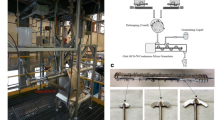Abstract
Chopper presence and then chopper speed was varied during wet high shear granulation of a placebo formulation using a PMA-1 granulator while also varying the impeller speed. The granules were extensively analyzed for differences due to the chopper. The effect of the chopper on the granules varied with impeller speed from no effect at a low impeller speed of 300 rpm to flow interruptions at an impeller speed of 700 rpm to minimal impact at very high impeller speeds as caking at the bowl perimeter obscured the effect of the chopper on the flow pattern. Differences in the granule flowability were minimal. However, it was concluded that the largest fraction of optimal granules would be obtained at an impeller speed of 700 rpm with the chopper at 1,000 rpm allowing balances between flow establishment, segregation, and centrifugal forces.












Similar content being viewed by others
REFERENCES
Litster J, Ennis B. The science and engineering of granulation processes. Netherlands: Kluwer; 2004.
Lindberg NO, Jönsson C. The granulation of lactose and starch in a recording high-speed mixer, Diosna P25. Drug Dev Ind Pharm. 1985;11:387–403.
Bock TK, Kraas U. Experience with the Diosna mini-granulator and assessment of process scalability. Eur J Pharm Biopharm. 2001;52:297–303.
Michaels JN, Farber L, Wong GS, Hapgood K, Heidel SJ, Farabaugh J, et al. Steady states in granulation of pharmaceutical powders with application to scale-up. Powder Tech. 2009;189:295–303.
Holm P. Effect of impeller and chopper design on granulation in a high speed mixer. Drug Dev Ind Pharm. 1987;12(9–11):1675–701.
Chitu TM, Oulahna D, Hemati M. Wet granulation in laboratory-scale high shear mixers: effect of chopper presence, design and impeller speed. Powder Tech. 2011;206:34–43.
Wang S, Ye G, Heng PWS, Ma M. Investigation of high shear wet granulation processes using different parameters and formulations. Chem Pharm Bull. 2008;56:22–7.
Kiekens F, Córdoba-Díaz M, Remon JP. Influence of chopper and mixer speeds and microwave power level during the high-shear granulation process on the final granule characteristics. Drug Dev Ind Pharm. 1999;25:1289–93.
Hoornaert F, Wauters PAL, Meesters GMH, Pratsinis SE. Agglomeration behaviour of powders in a Lödige mixer granulator. Powder Tech. 1998;96:116–28.
Logan R, Briens L. An investigation of the effect of impeller shear on granules formed through high shear granulation. Drug Dev Ind Pharm. 2011 (in press).
Litster JD, Hapgood KP, Michaels JN, Sims A, Roberst M, Kameneni SK. Scale-up of mixer granulators for effective liquid distribution. Powder Tech. 2002;124:272–80.
Alkhatib AK, Briens L. Influence of initial mixing on granule properties. 5th International Granulation Workshop, Lausanne, Switzerland. 2011.
Abdullah EC, Geldhart D. The use of bulk density measurements as flowability indicators. Powder Tech. 1999;102:151–65.
Carr R. Evaluating flow properties of solids. Chem Eng. 1965;72:163–8.
Nagel KM, Peck GE. Investigating the effects of excipients on the powder flow characteristics of theophylline anhydrous powder formulations. Drug Dev Ind Pharm. 2003;29:277–87.
ACKNOWLEDGMENTS
The authors would like to acknowledge the Natural Sciences and Engineering Research Council of Canada (NSERC) for their financial support.
Author information
Authors and Affiliations
Corresponding author
Rights and permissions
About this article
Cite this article
Briens, L., Logan, R. The Effect of the Chopper on Granules from Wet High-Shear Granulation Using a PMA-1 Granulator. AAPS PharmSciTech 12, 1358–1365 (2011). https://doi.org/10.1208/s12249-011-9703-1
Received:
Accepted:
Published:
Issue Date:
DOI: https://doi.org/10.1208/s12249-011-9703-1




